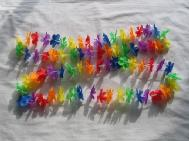(Minghui.org) Using the cover name “Shandong Province Xing-Ye Development Co. Ltd.,” the Shandong Women’s Prison has signed a number of contracts to make merchandise. Before it moved to its current location, the prison had nine prison wards, in which prisoners were forced to work like slaves. Ward 6 was home for prisoners age 60 or older and ones with physical issues and disabilities, and its work load was not as heavy as in other areas. But every prisoner still had to meet their quotas every day. Even those with mental disorders and physical handicaps were required to work. Every day, some prisoners pulled carts in which some elderly and handicapped people were carried to work. Ward 2 made toys, and Ward 7 was a packing workshop.
Wards 1, 3, 4, 5 and 8 made clothes. In order to maximize productivity and profit, prison officials set up competitive quotas. They set performance goals for the guards, and their bonuses and promotions were contingent upon it. Even the prisoners’ sentence reduction and parole were linked to production output. This caused fierce competition between prison wards, as well as the work load and pressure to deliver escalated. Due to concerns from society and international outcry against slave labor in prisons, the Women’s Prison made some concessions. In the past, prisoners had to work 18 hours a day, and occasionally they even worked 24 hour days. Currently, they reduced the work time to 10 hours, and told outside sources it is 8 hours. Despite the work hour reduction, the total output was actually increased. The prison guards used a variety of ways to push for increased productivity. They pressured group leaders (prisoners), used rewards and punishment, physical beatings and verbal assaults, and reduced break and meal times. Some secretly forced the prisoners to work overtime.
Prison authorities assigned police officers to bid for more contracts. Most contracts came from international trading companies and first-tier clothing suppliers to those trading companies. Large quantities of clothing and toys were exported to the US, Japan, South Korea, Russia, Germany and other countries. A number of brand names, including Pierre Cardin, were made in these prisons. When foreign trade contracts were low, the prison also took domestic contracts, including military and police uniforms, and other merchandise.
I remember at least three brand names that had big orders. One is ABC Children Clothes. The ABC Company was founded in Taiwan in 1983, and it is a well-known brand in China.
The other is Charles River Apparel sports clothing. The tags showed “export to the US.” Its logo is shown here.
The prison also made massive production of “Han-Si” down jackets. Its logo is shown here.
The Wangcun Forced Labor Camp in Zibo, Shandong Province is another place where merchandise is massively produced by using slave laborers. Wangcun Labor Camp was built in 2004 especially for persecuting female practitioners in Shandong Province. Several thousand practitioners (age 20 to 60) have been detained, tortured, and forced to do slave labor there. At peak times, nearly 600 practitioners were detained there. The monthly food budget for each prisoner was merely 150 yuan, yet they were forced to perform heavy labor without compensation.
Practitioners were subjected to many rounds of brainwashing methods. Each newly arrived practitioner was monitored by several inmates, and locked in a solitary confinement cell. The practitioner had to use the cell as bedroom, dining room and restroom. Practitioners who refused to renounce their belief suffered from extended standing punishment: they were beaten, cursed, hung up, and denied toilet use and sleep deprivation.
After practitioners were forced to sign statements renouncing their belief, they were put to work as slaves. Work time started at 5:00 a.m. and ended at 10:30 p.m. They were forced to sing communist “red songs,” and write weekly diaries and monthly summary reports. In these reports, they are forced to denounce Falun Gong’s Master and their practice. Even illiterate elderly women had to verbalize their denunciation and have others write it down.
The products made at Wangcun Labor Camp included door curtains, glass beads, knitted sleeveless shirts, hand bags, quilts, toys, Christmas trees, peeled garlic, and pencil packs. They also had to do other forms of manual work: labeling, packing, washing glassware, vases, and wrapping electrical coils. Wangcun Labor Camp also took contract work from clothing companies based in Weiqiao, Shandong Province.









